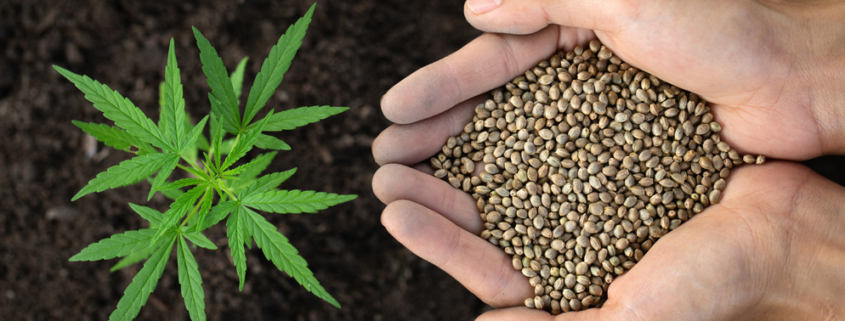Ask a dozen farmers whether or not hemp requires fertilizer, and you’re likely to get a dozen different answers. Some farmers swear that hemp doesn’t need a drop of fertilizer. Most farmers, however, believe at least some hemp fertilizer is necessary. While certain farmers may think less is more, many successful farmers treat hemp like any other crop, meaning they educate themselves on hemp fertilizer requirements, test their soil, and regularly fertilize their crop.
The Case for Using Hemp Plant Fertilizer
While hemp has a well-deserved reputation as a robust crop that can grow in a variety of soils and climates, that doesn’t mean it does best when planted and left alone. Like most other crops, hemp requires the big NPK, or nitrogen, phosphorus, and potassium. A hemp crop can also benefit from receiving the right combination of micronutrients and even some beneficial fungus.
Farmers who are serious about making the best return on investment from their hemp crop need to give their plants every possible advantage. That includes providing the right nutrients to help every plant grow strong and healthy. For many farmers, profitability can increase dramatically on the margins. Healthy hemp plants that provide a 1% increase in CBD or CBG content could an increased profit of thousands of dollars per acre. That can more than make up for the extra time and cost it takes to build and implement a custom fertilization plan.
Start with a Soil Test
Set your hemp crop up for success by prepping your soil before you begin planting. Hemp has specialized nutritional needs, and if you can make your soil as welcoming as possible to hemp seeds or hemp starts, your plants have a higher chance of thriving.
This starts with a soil test. After all, you can’t fix your soil if you don’t know what the deficiencies are. Work with an agronomist or with your existing fertilization company to take soil samples of your field. Make sure the person or company you’re working with has experience with hemp.
Your soil specialist will be able to interpret your soil results and provide you with a fertilization plan to get your soil ready for planting season.
Hemp Fertilizer Components
What are the fertilizer requirements for hemp? While the exact products and ratios will vary based on your soil, goals, and personal preferences, the basic chemical components of hemp plant fertilizer are the same.
Nitrogen
Like many crops, hemp is hungry for nitrogen. In an interview with the website Growing for Market, Zach Menchini, a representative for fertilizing company Concentrates, Inc., suggests adding 100 pounds of nitrogen per acre, increasing to 120 pounds per acre if the soil is particularly nitrogen deficient. Fish emulsion is a popular product farmers use to add nitrogen to their fields.
Phosphorus
Some farmers make the mistake of assuming hemp fields need a large amount of phosphorus to support big, healthy hemp buds, but the truth is that hemp does well with a standard amount of phosphorus. Menchini suggests applying 50 pounds of phosphorus per acre.
Potassium
Hemp is a big consumer of potassium compared with most other crops, so farmers should make sure they add enough to their field. Menchini recommends 80 pounds of potassium per acre. One of the best ways to add potassium to your field is through the use of kelp extract. Kelp extract is relatively expensive, so not every farmer will have the budget for this particular soil amendment. (This is a good reason to create a robust crop plan, including a conservative budget, before planting hemp.)
Calcium
Calcium is another ingredient in industrial hemp fertilizer requirements. Menchini mentions that a common mistake farmers make is to apply their phosphorus at the same time as their calcium. Phosphorus is not a very mobile chemical, and when it comes in contact with calcium, it can bond with the calcium, turning in unhelpful calcium phosphate. This is a good reason to start fertilizing your fields early so you have the time to allow the soil to absorb nutrients in the right order.
Sulfate
Adding a relatively small amount of sulfate to your fields, roughly 20 pounds per acre according to Menchini, can help your hemp thrive.
Boron
Not every hemp field will require boron. Unfortunately, soil tests aren’t very good at measuring boron. It’s a smarter idea to have your testing company perform a leaf analysis of your crop about mid-way through the season to see if you need to add boron.
Fungus
Don’t mistake fungus for mold (which is part of the fungus family and can be a major problem for your hemp crop). In his Growing for Market interview, Menchini mentions that mycorrhizal fungi can act as a symbiotic partner to hemp plants. Inoculating seedlings with mycorrhizal fungi can greatly increase the absorptive abilities of the plants by basically acting as an extended root system.
Lime
Hemp does best in slightly acidic soil. If your soil test shows that your soil is too acidic, one way to push the acidity down (toward a more alkaline soil) is to apply lime. Menchini suggests a maximum limit of two tons of lime per acre.
Compost
Compost can be a great way to build up a strong soil structure and bring more organic life into your soil, but take care in the compost you use. Some compost contains a high amount of salt, while other compost may push your potassium levels too high. Only work with a compost supplier who regularly tests their compost and reviews the potassium and salt levels of your compost before applying it to your field.
Frontloading Hemp Fertilizer vs. Fertigation
Some farmers love using slow-release fertilizers to “frontload” their soil before planting. The idea is that the slow-release fertilizers will consistently provide hemp plants with just the right amount of fertilizer in the right ratio throughout the growing season.
While frontloading offers a significant amount of convenience and can help limit labor needs throughout the growing season, it may not give farmers the best crop possible. Farmers who want to boost their margin as much as possible often choose to continually fertilize their crops throughout the growing season.
One of the most popular new ways to fertilize in this manner is through fertigation. As you may have determined from the name, fertigation is a combination of fertilization and irrigation, and it means adding liquid fertilizer to an irrigation system. Fertigation allows farmers to address nutritional deficiencies at any point in the growing season, and it can also reduce soil erosion and water consumption. One drawback, however, is that fertigation applies the same amount of nutrients to your entire crop. If only certain plants or clusters need a fertilizer boost, it may be smarter to apply nutrients in smaller batches.
Watch Out for Nutrient Burn
While ignoring your hemp fertilizer requirements could lead to a less-than-impressive yield, adding too much fertilizer can also harm your plants. Overfertilizing your hemp can lead to “nutrient burn.” Even the most experienced farmers may face nutrient burn (or “nute burn”), but it’s more common in the fields of new hemp farmers.
According to Grow Link, “Plants don’t have a mechanism to deal with ‘overfeeding,’ and so plants taking in more nutrients than they can handle get sick.” Fortunately, nutrient burn is relatively easy to spot, and it can even be reversed in some cases if recognized and addressed quickly.
Some of the early warning signs of nutrient burn, according to Grow Link include:
- Bending leaf tips
- Deep green coloration
- Slight yellowing or browning at the edges of the leaves
Keep your eyes on the tips of your leaves. If nutrient burn is happening, this is where you’ll see the first signs. As the nutrient burn worsens, you’ll notice more yellowing and browning in the leaves as well as leaves curling and twisting more noticeably.
The best way to address nutrient burn is to cut off all the infected parts of the hemp plant, including any browning or yellowing buds, followed by flushing your soil with heavy irrigation using pH-balanced water.
Create a Hemp Feeding Chart
Unless you plan on frontloading hemp fertilizer, you’ll need to set up a schedule for fertilizing your hemp crop before and during the growing season. Experienced farmers may be able to set up their own feeding charts after receiving their soil tests. New farmers, however, should strongly consider working with an agronomist or reputable fertilization company to develop a personalized feeding chart for their soil, crop, and goals.
Choosing the right hemp fertilization plan can go a long way toward keeping your crop healthy and happy all the way through to harvest. To give yourself another leg up, make sure to choose high-quality hemp seeds and starts. At High Grade, our hemp strains have all been proven through rigorous breeding and testing protocols. We only sell hemp strains that meet our exacting expectations for the best genetics. Contact us today to learn more about our CBD and CBG hemp strains.



